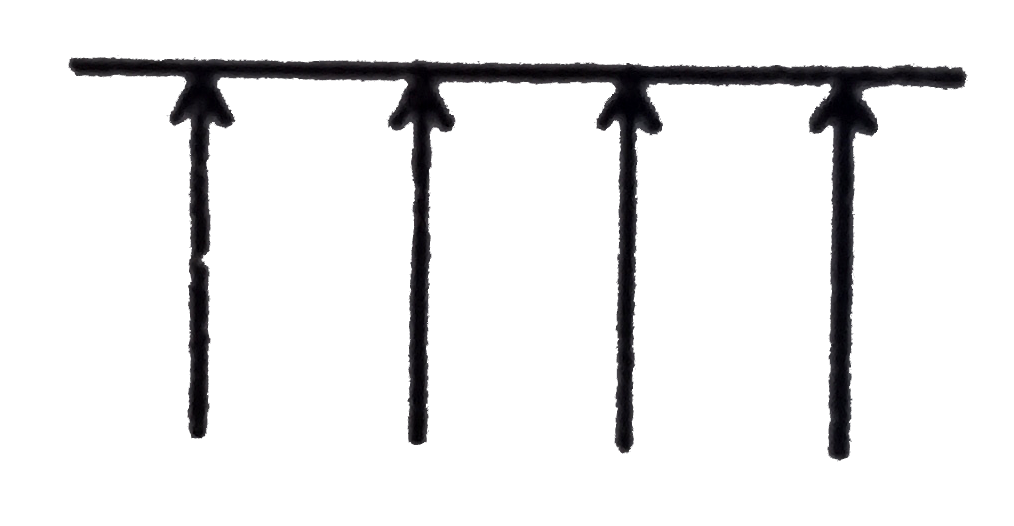A plate of mass 20mg is in equilibrium in air due to force exerted by light beam on the plate as shown is the figure. Calculate the power of the beam (in mega-watt) if the plate is perfectly absorbing.
'(##CEN_KSR_PHY_JEE_CO28_E01_018_Q01##)'
The correct Answer is:60
To solve the problem, we need to calculate the power of a light beam that exerts enough force to keep a plate of mass 20 mg in equilibrium. Here are the steps to arrive at the solution:
Step 1: Convert mass to kilograms
The mass of the plate is given as 20 mg. We need to convert this to kilograms for our calculations.
Mass=20mg=20×10−3g=20×10−6kg=2×10−5kg
Step 2: Calculate the weight of the plate
The weight (force due to gravity) of the plate can be calculated using the formula:
Weight=m⋅g
Where g (acceleration due to gravity) is approximately 9.81m/s2.
Weight=2×10−5kg⋅9.81m/s2=1.962×10−4N
Step 3: Relate the force exerted by the light beam to the power of the beam
For a perfectly absorbing plate, the force exerted by the light beam can be expressed in terms of the power P of the beam and the speed of light c:
F=Pc
Where c (speed of light) is approximately 3×108m/s.
Step 4: Set the forces equal for equilibrium
Since the plate is in equilibrium, the force exerted by the light beam is equal to the weight of the plate:
Pc=Weight
Substituting the values we have:
P3×108=1.962×10−4
Step 5: Solve for power P
Now we can solve for P:
P=1.962×10−4×3×108
Calculating this gives:
P=5.886×104W
Step 6: Convert power to megawatts
To convert watts to megawatts, we divide by 106:
P=5.886×104106=0.05886MW
Final Answer
Thus, the power of the beam is approximately:
P≈0.05886MW
The mass of the plate is given as 20 mg. We need to convert this to kilograms for our calculations.
The weight (force due to gravity) of the plate can be calculated using the formula:
For a perfectly absorbing plate, the force exerted by the light beam can be expressed in terms of the power P of the beam and the speed of light c:
Since the plate is in equilibrium, the force exerted by the light beam is equal to the weight of the plate:
Now we can solve for P:
To convert watts to megawatts, we divide by 106:
Thus, the power of the beam is approximately:
Topper's Solved these Questions
Similar Questions
A plate of mass 10g is in equilibrium in air due to the force exerted by a light beam on the plate. Calculate power of the beam. Assume that the plate is perfectly absorbing.

View SolutionA plate of mass 10gm is in equillibrium in air due to the force exterted by light beam on plate. Calculate powder of beam. Assume plates is perfectly absorbing.

View SolutionMaximum power loss (in watt) in the given circuit is
'(##CEN_KSR_PHY_JEE_C24_E01_020_Q10##)'
View SolutionIn the given circuit, the voltmeter records 5V. The resistance (in ohm ) of the voltmeter is :
'(##CEN_KSR_PHY_JEE_CO20_E01_031_Q25##)'
View SolutionThe potential (in volt) of point P in the given diagram will be
'(##CEN_KSR_PHY_JEE_CO20_E01_019_Q14##)'
View SolutionIn the circuit shown, find the value of current I (in ampere).
'(##CEN_KSR_PHY_JEE_CO20_E01_037_Q31##)'
View SolutionThe value of maximum power (in watt) delivered to R is
'(##CEN_KSR_PHY_JEE_CO20_E01_029_Q23##)'
View SolutionA periodic voltage V varies with time t as shown in the figure. T is the time period. The ms value of the voltage is V0k. Find k.
'(##CEN_KSR_PHY_JEE_C24_E01_004_Q02##)'
View SolutionFind n, if the total power dissipated in the circuit is 6n watts.
'(##CEN_KSR_PHY_JEE_CO20_E01_034_Q28##)'
View SolutionCalculate the time constant (in second), of the circuit.
'(##CEN_KSR_PHY_JEE_CO20_E01_032_Q26##)'
View Solution

